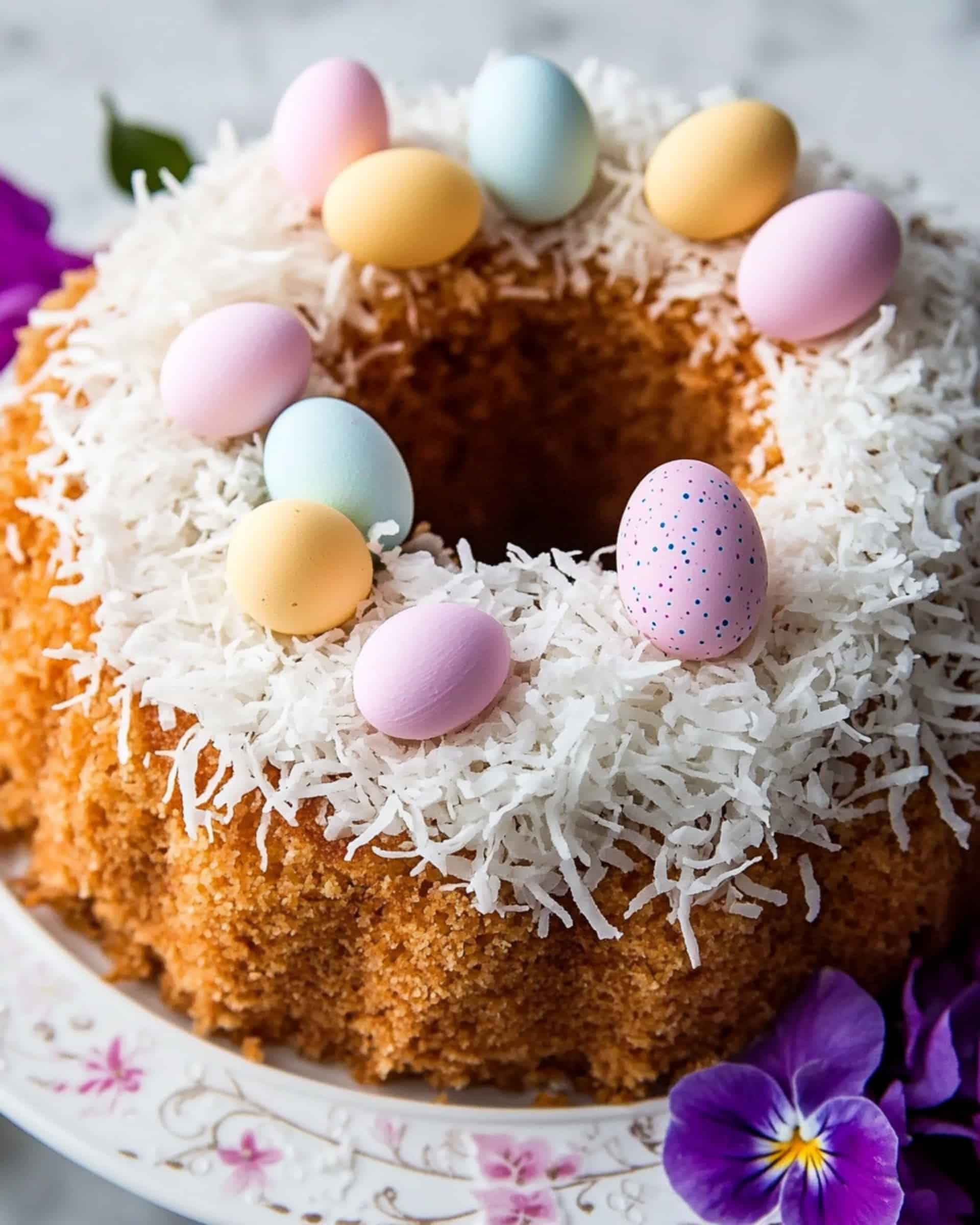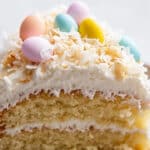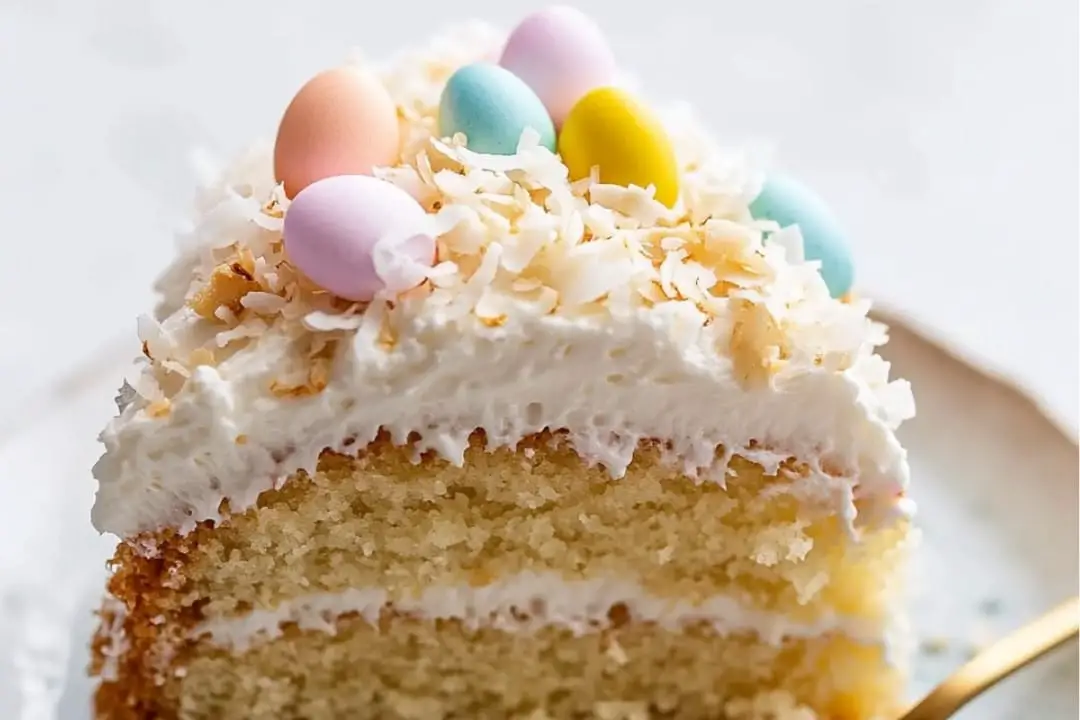This spectacular Easter Cake is a celebration in every bite! A moist, coconut-lemon bundt cake topped with tangy cream cheese frosting, shredded coconut, and festive candy eggs creates the perfect centerpiece for your spring gatherings. The combination of bright citrus flavors and sweet coconut makes this cake irresistibly delicious while being surprisingly simple to prepare.
Why You’ll Love This Recipe
- Show-stopping presentation: This beautiful bundt cake decorated with coconut “nest” and colorful candy eggs makes an impressive centerpiece with minimal decorating skills required.
- Perfect balance of flavors: The combination of lemon and coconut creates a refreshing springtime taste that’s not too sweet but incredibly satisfying.
- Make-ahead friendly: Prepare this cake a day in advance to make your Easter celebration stress-free while still serving something spectacular.
- Crowd pleaser: The familiar flavors with a special twist make this cake appeal to both kids and adults at your gathering.
Ingredients You’ll Need
- Cake flour: Creates a tender, light crumb that’s essential for this special occasion cake. The lower protein content makes a significant difference in the final texture.
- Baking powder and baking soda: The leavening agents that give the cake its beautiful rise and soft texture.
- Butter: Provides richness and a velvety texture to the cake while creating a sturdy structure.
- Granulated sugar: Sweetens the cake and helps create moisture when creamed with the butter.
- Lemon zest and juice: Adds bright, fresh flavor that cuts through the richness. The zest contains those fragrant oils that really amp up the lemon flavor.
- Vegetable oil: Helps keep the cake moist for days after baking, even when refrigerated.
- Eggs: Provide structure, richness, and help bind the ingredients together.
- Vanilla and coconut extracts: The vanilla provides a warm background note while the coconut extract enhances the coconut flavor throughout the cake.
- Sour cream: Adds moisture and tanginess that balances the sweetness perfectly.
- Milk: Creates a perfect batter consistency while adding tenderness to the cake.
- Sweetened flaked coconut: Adds texture inside the cake and creates the decorative “nest” on top.
- Cream cheese and butter (for frosting): The base for that tangy, rich frosting that pairs perfectly with the lemon cake.
- Confectioners’ sugar: Sweetens and thickens the frosting to the perfect spreading consistency.
- Candy-coated chocolate eggs: The perfect decorative finish that turns this into a true Easter celebration cake.
Variations
Love this cake concept but want to make it your own? Try these creative variations:
- Coconut lover’s dream: Toast the coconut topping for a nuttier flavor and gorgeous golden color that adds visual dimension.
- Citrus swap: Replace the lemon with orange or lime for a different citrus profile. Orange pairs beautifully with coconut for a tropical twist.
- Filling surprise: After the cake has cooled, use a knife to cut a channel around the top of the cake, fill with additional frosting or lemon curd, and replace the cake top before frosting.
- Berry addition: Fold 1 cup of fresh blueberries or raspberries into the batter for pops of color and bursts of fruity flavor.
How to Make Easter Cake
Step 1: Prepare Your Pan and Ingredients
Preheat your oven to 350°F. Thoroughly grease your bundt pan—be generous to ensure the cake releases perfectly. Measure out all ingredients and bring refrigerated items to room temperature.
Step 2: Mix the Dry Ingredients
Whisk together cake flour, baking powder, baking soda, and salt in a medium bowl. This evenly distributes the leavening agents for a perfect rise.
Step 3: Cream Butter, Sugar, and Zest
Beat the butter until smooth, then add sugar and lemon zest, beating for 3-4 minutes. Don’t rush this step—proper creaming incorporates air that helps create a light texture. Add oil and combine thoroughly.
Step 4: Add Wet Ingredients
Add eggs one at a time, then mix in sour cream, vanilla, and coconut extracts. This gradual addition prevents curdling and ensures everything incorporates smoothly.
Step 5: Alternate Dry Ingredients and Milk
Combine lemon juice and milk, then alternate adding dry ingredients and the milk mixture. This method prevents overmixing while ensuring all ingredients blend properly. Fold in the coconut last.
Step 6: Bake the Cake
Spoon the batter into your prepared bundt pan and bake for 55-65 minutes. The cake is done when the edges are golden brown and a toothpick inserted comes out clean or with a few moist crumbs.
Step 7: Cool Completely
Let the cake cool in the pan for 2 hours before inverting onto a serving plate. This cooling time allows the structure to set properly and prevents breaking when unmolded.
Step 8: Make the Frosting
Beat cream cheese and butter until smooth, then add confectioners’ sugar, lemon juice, and vanilla. Beat until fluffy and smooth. Adjust consistency with more lemon juice if needed.
Step 9: Decorate
Frost the cooled cake, then press coconut onto the frosting to create a “nest” effect. Fill the center hole with colorful candy eggs for that perfect Easter touch.
Pro Tips for Making the Recipe
- Room temperature ingredients matter: Cold ingredients don’t incorporate properly, resulting in a dense cake. Set everything out at least an hour before baking.
- Don’t overmix the batter: Once you add the flour, mix just until combined to avoid developing gluten that makes the cake tough.
- Grease the bundt pan thoroughly: Use butter or shortening and get into every crevice, or try a baking spray with flour for perfect release.
- Check for doneness correctly: Insert a toothpick in the thickest part of the cake—it should come out clean or with a few moist crumbs, not wet batter.
- Let the cake cool completely: Trying to frost a warm cake will result in melted frosting sliding right off.
How to Serve

This Easter cake is versatile enough to fit various serving styles:
Dessert Table Centerpiece
Place the decorated cake on a raised cake stand at the center of your dessert table for maximum impact.
With Beverages
Serve slices with fresh coffee, tea, or even a glass of champagne for an adult Easter brunch.
Alongside Other Spring Treats
Pair with fresh berries, whipped cream, or even a scoop of vanilla ice cream for an extra-special dessert.
Make Ahead and Storage
Storing Leftovers
Store frosted cake in the refrigerator, covered with a cake dome or loosely with plastic wrap, for up to 5 days. The cake actually improves in flavor after a day as the flavors meld.
Freezing
You can freeze the unfrosted cake for up to 3 months. Wrap the completely cooled cake in plastic wrap, then aluminum foil. Thaw overnight in the refrigerator before frosting and decorating.
Reheating
For the best texture, let refrigerated slices sit at room temperature for about 30 minutes before serving. This allows the butter in the cake to soften, improving the texture and flavor.
FAQs
Can I make this cake without a bundt pan?
Yes, you can bake this batter in two 9-inch round cake pans for about 25-30 minutes. Cool completely, then frost between layers and on top. Decorate the top with coconut and candies for a similar effect.
Why did my cake stick to the bundt pan?
This typically happens when the pan isn’t greased thoroughly enough. For best results, use a pastry brush to apply melted butter to every crevice, or use a baking spray with flour. Also, make sure to let the cake cool in the pan for the full 2 hours to set properly.
Can I make this cake without coconut?
Absolutely! You can omit the coconut extract and flaked coconut for a pure lemon cake. Decorate the top with sprinkles or fresh berries instead of coconut for a different spring look.
How can I ensure my cream cheese frosting isn’t runny?
Make sure your cream cheese and butter are softened but not warm or melty. Start with less lemon juice and add more only if needed. If your kitchen is warm, refrigerate the frosting for 15-20 minutes before spreading it on the cake.
Final Thoughts
This Easter Cake brings together the bright flavors of spring with a show-stopping presentation that requires surprisingly little effort. The combination of lemon and coconut creates a refreshing, festive dessert that’s sure to become a new tradition for your Easter celebrations. Whether you’re hosting a large gathering or a small family meal, this cake is guaranteed to bring smiles to everyone at your table
Print
Easter Cake Recipe
- Prep Time: 35 minutes
- Cook Time: 1 hour
- Total Time: 4 hours
- Yield: 10-12 servings
- Category: Desserts
- Method: Baking
- Cuisine: Easter-inspired, American
- Diet: Vegetarian
Description
A delightful and moist Easter Cake recipe with layers of citrus flavors, coconut, and a luscious lemon cream cheese frosting. Perfect for celebrations or a creative dessert idea.
Ingredients
Cake
- 3 cups (360g) cake flour (spooned & leveled)*
- 3 teaspoons baking powder
- 1/2 teaspoon baking soda
- 1/2 teaspoon salt
- 1 cup (16 Tbsp; 226g) unsalted butter, softened to room temperature
- 1 and 3/4 cups (350g) granulated sugar
- 1 heaping Tablespoon lemon zest
- 1/2 cup (120ml) vegetable oil
- 5 large eggs, at room temperature
- 2 teaspoons pure vanilla extract
- 1 teaspoon coconut extract
- 1/2 cup (120g) full-fat sour cream or plain yogurt, at room temperature
- 2/3 cup (180ml) whole milk, at room temperature
- 1/4 cup (60ml) fresh lemon juice
- 1 cup (100g) sweetened flaked/shredded coconut
Lemon Cream Cheese Frosting
- 8 ounces (226g) full-fat brick cream cheese, softened to room temperature
- 1/4 cup (4 Tbsp; 56g) unsalted butter, softened to room temperature
- 2 cups (240g) confectioners’ sugar
- 1-2 Tablespoons (15-30ml) fresh lemon juice
- 1 teaspoon pure vanilla extract
For Topping
- 1 and 1/2 cups (150g) sweetened flaked/shredded coconut*
- 1–2 cups candy-coated chocolate eggs, such as Cadbury Mini Eggs
Instructions
- Prepare the Bundt Pan: Preheat oven to 350°F (177°C). Generously grease a 10- to 12-cup Bundt pan.
- Mix Dry Ingredients: Whisk the cake flour, baking powder, baking soda, and salt together in a medium bowl. Set aside.
- Cream the Butter: In a large bowl using a handheld or stand mixer fitted with a paddle attachment, beat the butter on high speed until smooth and creamy, about 1 minute. Add the granulated sugar and lemon zest; beat on high speed for 3–4 minutes until creamed. Scrape down sides and up the bottom of the bowl as needed.
- Add Liquids: Add the oil and mix on medium speed to combine. With the mixer running on low speed, add eggs one at a time, then sour cream, vanilla, and coconut extracts. Beat until combined.
- Prepare Milk Mixture: Whisk the lemon juice and milk together.
- Combine Batter: With the mixer on low speed, add dry ingredients in 3 additions, alternating with the lemon-milk mixture. Mix until just incorporated. Do not over-mix. Fold in coconut.
- Fill Bundt Pan: Spoon or pour batter evenly into the Bundt pan and bake for 55–65 minutes. Cover loosely with foil halfway through if browning too quickly.
- Cool Cake: Allow cake to cool for 2 hours in the pan on a rack. Invert onto serving plate and let it cool completely before decorating.
- Make the Frosting: Beat cream cheese and butter on medium speed until smooth (about 2 minutes). Add confectioners’ sugar, 1 Tablespoon lemon juice, and vanilla extract. Beat on high for 3 minutes. Adjust texture with additional lemon juice if necessary.
- Frost and Decorate: Frost the cooled Bundt cake using an icing spatula or knife. Top with shredded coconut and fill the Bundt’s center with candy-coated chocolate eggs. Serve or refrigerate until ready.
- Storage: Cover leftover cake tightly and refrigerate for up to 5 days. Let sit at room temperature for about 30 minutes before serving.
Notes
- Make Ahead: Cake can be baked and cooled 1 day in advance. Decorate the next day or serve directly after frosting.
- Freezing Instructions: Wrap unfrosted cake tightly in plastic wrap and aluminum foil, then freeze for up to 3 months. Thaw overnight in the refrigerator before frosting.
- Room Temperature Ingredients: For ideal mixing consistency, ensure refrigerated ingredients are at room temperature before use.
- Alternate Frostings: Use lemon buttercream if cream cheese frosting isn’t preferred.
- Substitutions: Sour cream can be replaced with full-fat plain yogurt, and whole milk can be substituted with lower-fat or nondairy milk in a pinch.
Nutrition
- Serving Size: 1 slice
- Calories: 400-450
- Sugar: 40g
- Sodium: 250-270mg
- Fat: 20g
- Saturated Fat: 12g
- Unsaturated Fat: 6g
- Trans Fat: 0g
- Carbohydrates: 55g
- Fiber: 1g
- Protein: 5g
- Cholesterol: 100mg




Your email address will not be published. Required fields are marked *